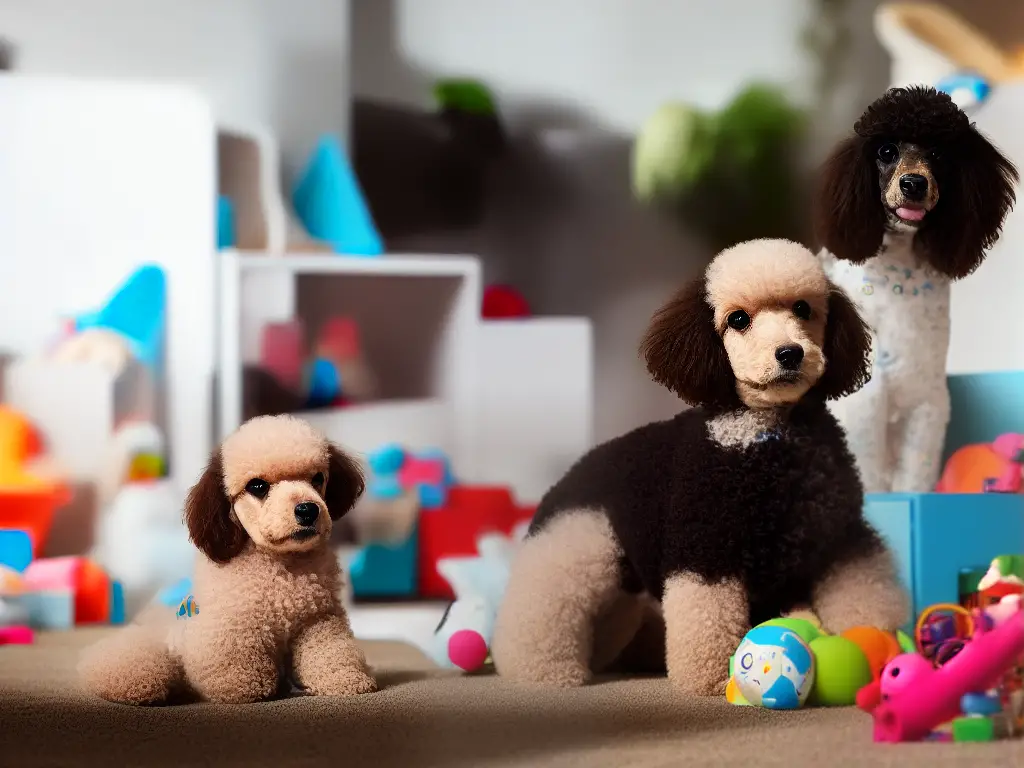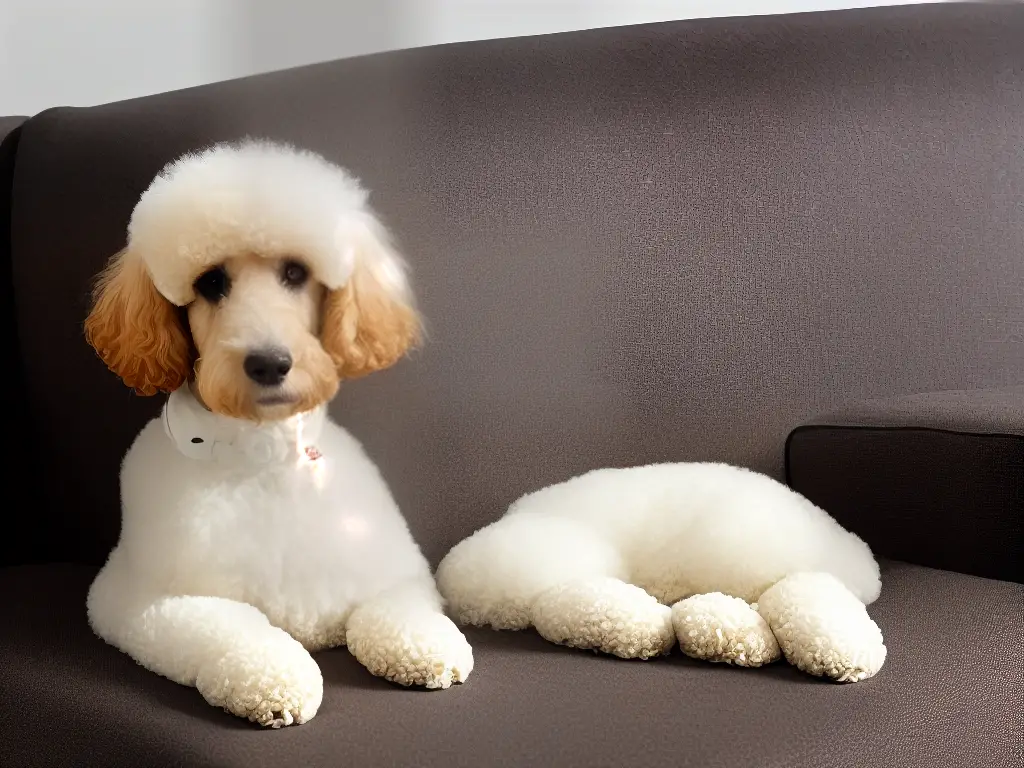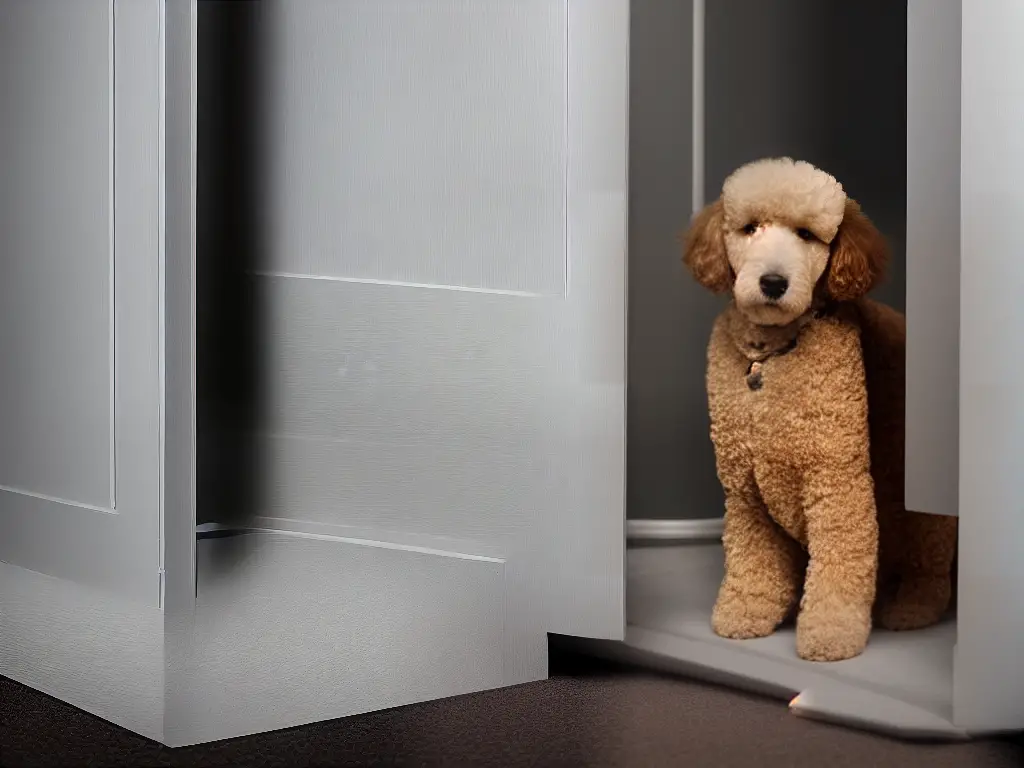Poodle Separation Anxiety: Causes and How to Reduce
Separation anxiety is a common issue that affects many dog breeds, but it can be particularly prevalent in poodles. This highly intelligent and sensitive breed often forms strong bonds with their owners, making them more susceptible to emotional distress when separated. In order to better understand and address this issue, it is crucial for poodle owners to educate themselves on the various aspects of separation anxiety, its causes, effects, prevention, and treatment options. This essay aims to provide a comprehensive and informative insight into poodle separation anxiety, offering guidance and support for those seeking to improve their dog’s quality of life.
Understanding Poodle Separation Anxiety
Separation anxiety is a common behavioral issue faced by numerous dog breeds, including poodles. At its core, separation anxiety refers to a dog’s intense fear or distress when separated from their human family members. Poodles are highly intelligent and form strong bonds with their owners, which can contribute to their susceptibility to separation anxiety. It is essential to understand that this condition can have significant negative impacts on a poodle’s physical and mental health if left unaddressed.
The triggers for separation anxiety in poodles can vary, but the most common trigger is the absence of a familiar person. This can include drastic changes in the owner’s schedule, sudden prolonged absences or a new home environment. Additionally, various factors such as genetics, the dog’s upbringing or history of abandonment could contribute to separation anxiety in poodles. Identifying the triggers of your poodle’s anxiety will facilitate the implementation of effective coping strategies and treatment plans.
Recognizing the signs of separation anxiety in poodles is crucial for addressing the problem early and ensuring the dog’s wellbeing. Common signs of separation anxiety in poodles include excessive barking, whining or howling, destructive behavior when left alone, inappropriate elimination, and attempts to escape. Besides these overt symptoms, poodles may also display subtler signs such as drooling, pacing, or increased heart rate when owners prepare to leave. By identifying the classic signs of separation anxiety in your poodle, you will be better equipped to take appropriate action and seek professional help, if necessary.
To manage or minimize the impacts of separation anxiety in poodles, you may need to employ a combination of approaches. Some potential strategies include gradual desensitization to their owner’s absence, building positive associations with being alone, and establishing a consistent routine. These strategies will help reduce the dog’s reliance on their owner’s presence and help them feel more secure in their environment. In more severe cases, it might be necessary to consult with a professional dog behaviorist or veterinarian to develop a comprehensive treatment plan that may include behavioral modification techniques or medication.
Understanding the complicated issue of poodle separation anxiety is vital for maintaining the happiness and health of these sensitive dogs. By identifying the triggers, recognizing the symptoms, and adopting effective treatment strategies, owners will be better equipped to help their poodles cope with separation anxiety. Furthermore, seeking professional advice when needed can minimize the negative impacts of this condition and ensure a fulfilling life for both owner and poodle.

Causes of Separation Anxiety in Poodles
One common reason for poodle separation anxiety is genetics. Just like humans, dogs can inherit certain traits and predispositions from their parents. If a poodle is prone to developing separation anxiety, it is likely that one or both of its parents also suffer from the disorder. Moreover, some dog breeds, like poodles, are known to be more susceptible to separation anxiety due to their social and sensitive nature. By acknowledging and addressing these factors, in addition to implementing the previously mentioned treatment strategies, poodle owners can effectively manage and reduce separation anxiety in their pets.
Another factor contributing to separation anxiety in poodles is their history of traumatic experiences. Poodles that have experienced trauma or distressing events, such as being abandoned or neglected, are likely to develop separation anxiety. Being rehomed multiple times, having inconsistent routines, or being exposed to stressful situations can also trigger feelings of insecurity and stress in a poodle, which may present as separation anxiety.
Environmental factors also play a role in causing separation anxiety in poodles. A lack of proper socialization during their early developmental stages can predispose poodles to separation anxiety. Puppies need to be exposed to a variety of people, dogs, and situations to develop the confidence and coping skills necessary for handling stress and anxiety. If a poodle does not receive adequate socialization during this crucial period, it may be more prone to developing separation anxiety later in life.
Additionally, the way an owner interacts with their poodle can be a contributing factor to separation anxiety. Overly doting or indulgent owners may inadvertently create an unhealthy dependency between themselves and their poodle. If the dog is constantly being reassured and comforted by its owner, it may struggle to cope when left alone. On the other hand, being too harsh or disciplining the poodle excessively can also create feelings of insecurity, leading to separation anxiety.
In conclusion, there are multiple factors that can cause separation anxiety in poodles, ranging from genetics to environmental influences. Understanding the effects of separation anxiety on poodles is crucial for their overall well-being. By understanding these causes and taking proactive steps to address them, poodle owners can help reduce the chances of their dog developing separation anxiety.

Effects of Separation Anxiety on Poodles
Implementing a consistent routine, providing proper socialization, and maintaining a balanced relationship with their poodle can all contribute to a happier and more secure dog. Separation anxiety is a common issue among poodles, which can have a significant impact on their overall health, behavior, and quality of life. This condition primarily affects poodles when they are left alone for extended periods or when their regular routine is disrupted. Poodles are known for their intelligence and strong attachment to their owners, making them particularly susceptible to separation anxiety.
One of the primary effects of separation anxiety on poodles is the development of behavioral issues. These can include excessive barking or whining, destructive behaviors like chewing or digging, and even attempts to escape their confined space. Some poodles may also exhibit signs of depression or aggression when their owners are away, making it difficult for them to interact positively with other people and animals. If left untreated, these behavioral issues can severely impact a poodle’s quality of life, making it challenging for the owner to manage their daily routines and interactions.
Separation anxiety can also lead to physical health concerns for poodles. The stress and anxiety associated with being separated from their owners can result in decreased appetite and digestive issues such as diarrhea and vomiting. Additionally, excessive barking and whining may lead to a strain on a poodle’s vocal cords, potentially causing lasting damage. In extreme cases, constant attempts to escape their confined space can result in self-inflicted injuries, further putting a poodle’s health at risk.
If separation anxiety is left untreated in poodles for an extended period, it can result in long-term consequences. Chronic stress has been linked to weakened immune systems, making poodles more susceptible to illnesses and infections. Additionally, the stress of separation anxiety can lead to a shorter lifespan for poodles, decreasing their overall quality of life. Long-term behavioral issues may also negatively affect the bond between the owner and their poodle, potentially leading to the difficult decision to rehome the dog.
Addressing separation anxiety in poodles can be challenging, but it is essential for a dog owner to understand and manage this condition. Gradual training techniques, such as desensitization and counter-conditioning, can help teach poodles to become more comfortable when left alone. Early detection and intervention are critical in preventing long-lasting effects on a poodle’s health and well-being.

Prevention and Management of Poodle Separation Anxiety
One common issue faced by poodle owners is separation anxiety, as these intelligent and sociable dogs tend to form strong bonds with their human family members. To prevent and manage this anxiety, positive reinforcement training is an effective method. By rewarding your poodle for displaying calm and independent behavior, they learn to associate being alone with positive feelings. Regular training sessions that gradually increase the amount of time your poodle spends alone can help them build confidence and feel more comfortable when you’re not around. In more severe cases, medications prescribed by a veterinarian may be necessary to reduce anxiety levels in poodles.
Another important aspect of preventing and managing poodle separation anxiety is early socialization. Exposing your poodle to various people, animals, and environments at a young age can help them feel more secure and adaptable in different situations. It is essential to gradually introduce your poodle to other dogs and people, preferably during their critical socialization period between 3 and 14 weeks of age. Proper socialization can help ensure that your poodle grows up to be a well-rounded and self-assured adult dog, reducing the likelihood of separation anxiety.
Environmental adjustments can also make a big difference in preventing and managing poodle separation anxiety. Creating a safe and comfortable space for your poodle to spend time in while you’re away can help them feel more secure. This can include providing a cozy bed, toys, and interactive puzzle feeders to keep them occupied. It may also be helpful to establish a consistent daily routine that includes designated times for play, exercise, and rest. This routine can help your poodle feel more settled and reduce their anxiety when you’re away from home.
In addition to these strategies, it’s essential to monitor your dog’s behavior and body language for signs of stress or anxiety. Some common indications of separation anxiety in poodles include excessive barking or whining, destructive behavior, and attempts to escape. If you notice any of these signs, consider consulting a professional dog behaviorist or veterinarian for assistance in developing a tailored plan to address your poodle’s specific needs.
Addressing separation anxiety in poodles requires patience, consistency, and an understanding of each individual dog’s needs. By using positive reinforcement training, ensuring proper socialization, and making environmental adjustments, you can help your poodle feel more secure and comfortable when left alone. It’s important to note that what works for one poodle may not always work for another, and working closely with a professional, if needed, can help effectively prevent and manage separation anxiety, fostering a happier and healthier relationship between you and your furry friend.

Treatments for Separation Anxiety in Poodles
Like many dogs, poodles can suffer from separation anxiety when left alone for extended periods. Behavioral therapy is one of the most commonly recommended treatments for this condition. This involves gradually acclimating your poodle to being alone by spending time away from them in small increments. As your dog becomes more comfortable with your absence, you can slowly increase the duration of time spent apart. This process, combined with the strategies mentioned in the previous paragraph, may require patience and consistency, but it can significantly reduce your poodle’s separation anxiety, ensuring their overall well-being and happiness.
Another option for treating separation anxiety in poodles is through the use of medications. Veterinarians may prescribe anti-anxiety medications like fluoxetine (Prozac) or clomipramine (Clomicalm) to help manage your dog’s distress. These medications have been shown to be effective in many cases, but they are not meant to be a long-term solution. Instead, they should be used in conjunction with behavioral therapy to create a more comprehensive treatment plan. It is essential to note that medications may have potential side effects like drowsiness, decreased appetite, or weight loss, which should be carefully monitored.
In addition to behavioral therapy and medication, alternative therapies may offer relief for poodles suffering from separation anxiety. One popular alternative therapy is the use of pheromone-based products, such as Adaptil, which release calming chemicals that can help ease your dog’s anxiety. Similarly, some pet owners have found success with CBD oil, a non-psychoactive extract derived from the hemp plant. Although there is limited scientific evidence supporting the use of CBD for treating separation anxiety, anecdotal evidence suggests that it may provide some relief for pets with mild to moderate anxiety.
Environmental enrichment can also play a significant role in treating poodle separation anxiety. Providing a comfortable and engaging environment for your dog when you are away can help alleviate their stress, distract them from your absence, and promote a feeling of safety. This may include offering puzzle toys, interactive games, or favorite treats and chews to occupy their time. Additionally, establishing a consistent routine and implementing mental and physical exercise daily can help in reducing anxiety, as this provides a structured environment for your poodle and can maintain its overall well-being.
Separation anxiety is a common issue faced by poodle owners as these dogs are social and intelligent breeds that form strong bonds with their families. In some cases, a poodle owner might find it challenging to manage their pet’s anxiety level, and as a result, seeking professional help may be necessary. Recognizing when this step is required is crucial for the well-being of both the poodle and the owner.

Professional Help and Support
One strategy for addressing poodle separation anxiety is using desensitization techniques. This may include playing recordings of sounds and stimuli, like doors closing or keys jangling, that your poodle commonly associates with your departure. By gradually increasing the volume and duration of these sounds, your dog may be able to acclimate to your absence and become more comfortable with the associated cues. Working closely with a behaviorist or veterinarian to individually tailor a desensitization plan for your poodle can potentially improve its quality of life and decrease anxiety when left alone.
Some of the common indicators that a poodle might need professional help due to separation anxiety include destructive behavior, excessive barking or howling, house soiling, or escaping from their confinement. While a certain level of clinginess or anxiety when left alone is normal, consistent excessive distress can be a sign that expert help is required.
Finding local resources, like a veterinarian who specializes in animal behavior or a certified dog behavior expert, can offer guidance on behavioral modification, training techniques, and, if necessary, medication to ease anxiety.
Online resources can also provide valuable information and support for poodle owners facing separation anxiety issues. Various forums and support groups are available on social media platforms, where poodle owners can share their experiences, advice, and recommendations. By joining these online communities, you gain access to a wealth of information from fellow poodle owners who have dealt with similar situations, as well as professionals who can provide insight and guidance.
Organizations such as the Association of Professional Dog Trainers (APDT) or the International Association of Animal Behavior Consultants (IAABC) can be helpful in finding a certified dog trainer or behavior consultant near you. Similarly, consulting with your local veterinarian can lead to local resources and referrals that may help address your poodle’s separation anxiety.
Being proactive in addressing poodle separation anxiety is essential, as early intervention can lead to a more successful outcome for both the dog and the owner. Utilizing professional help, online support groups, and educational resources can substantially improve the situation and ensure a healthier, happier relationship between you and your poodle. Integrating the advice from these sources into your daily training will equip you with the necessary tools to manage your poodle’s separation anxiety effectively.

Poodle Separation Anxiety Case Studies and Stories
A case study that highlights the importance of addressing separation anxiety in poodles is the story of Lucy, a miniature poodle who developed the issue shortly after her owners brought her home. Lucy would bark, scratch at doors, and chew on furniture when left alone. Her owners initially tried leaving her with a treat-filled Kong and playing calming music, but they observed minimal improvement. Eventually, they decided to consult a professional dog trainer who recommended doggy daycare as an alternative. Within a few months of attending daycare, Lucy’s separation anxiety had significantly decreased, and she began to feel more at ease when left alone. This instance serves as a prime example of how implementing the appropriate interventions and resources can effectively handle and alleviate poodle separation anxiety.
Another poodle owner’s experience involved working closely with a behaviorist to address their dog’s separation anxiety. Lulu, a toy poodle, would become extremely distressed when her owner left for work, often howling and urinating in the house. The behaviorist suggested using desensitization and counter-conditioning techniques to change Lulu’s emotional response to being left alone. The owner began leaving for shorter periods of time and incrementally increasing the duration, always ensuring Lulu’s comfort. They provided her with puzzle toys and high-value treats during these trials. Over time, Lulu became less anxious about her owner leaving and less likely to engage in destructive behaviors.
A different poodle owner found success using technology to help their standard poodle, Max, cope with separation anxiety. Max would incessantly cry whenever his owners left the house, so they decided to try using a pet camera with two-way audio. They set up the camera in a central location and spoke to Max via the two-way audio function whenever he started to get anxious. By providing verbal reassurance, Max learned that his owners were still present, even when they were not physically in the house. This strategy led to a drastic reduction in Max’s anxiety-related behaviors.
In another case, a dog named Penny benefited from a combination of medication and behavioral modification to treat her poodle separation anxiety. When her owners initially adopted Penny, they noticed that she would get very upset and destructive, even during brief absences. After consulting with their veterinarian, Penny was prescribed anti-anxiety medication, which they combined with crate training and gradually increased time alone. The combined treatment helped Penny feel calmer in her crate and experience significantly fewer anxiety symptoms.
Each of these stories illustrates that there is no one-size-fits-all solution to poodle separation anxiety, as various approaches can be effective depending on the individual dog and the severity of their symptoms. By exploring different methods, dog owners can find an approach that works best for them and their poodle, ultimately reducing the anxiety their pet experiences and improving their overall quality of life.

It is evident that poodle separation anxiety is a complex issue that requires understanding, patience, and a willingness to invest time and effort in exploring the best treatment and management options. By being proactive and utilizing the wealth of knowledge available, poodle owners can successfully navigate their dog’s separation anxiety journey, promoting a happier and healthier life for both the pet and their family. Through continued education, awareness, and compassionate care, we can work together to overcome the challenges faced by poodles with separation anxiety, ensuring that these affectionate and intelligent dogs can thrive in their forever homes.
